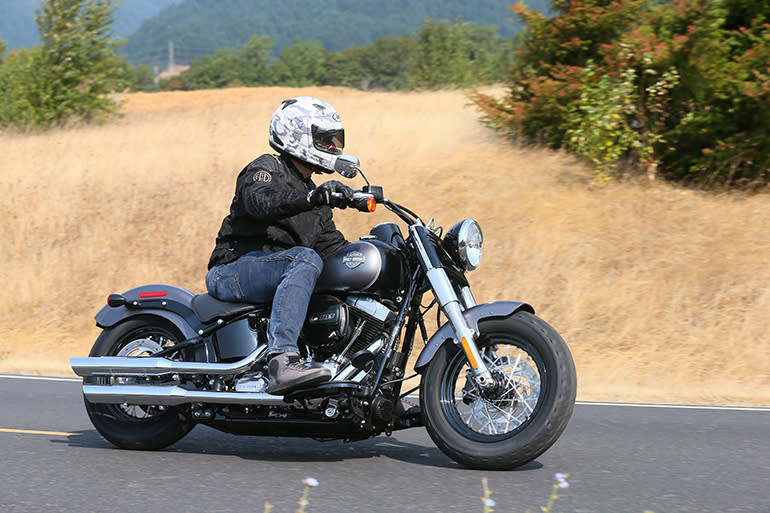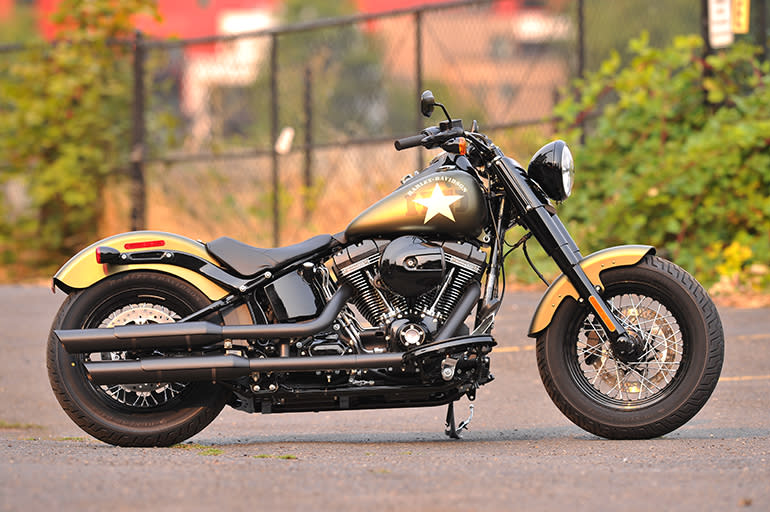Harley’s Fastest Softails Ever - We Ride the 2016 Harley-Davidson Softail Slim S and Fat Boy S
When I was a kid I wanted a Fat Boy. Maybe it was Terminator 2, watching that all-American movie hero Arnold Schwarzenegger (well his stunt double) jump a Fat Boy off a concrete embankment. I also wanted two beef patties and bacon on my cheeseburgers. I wanted acres of land. I wanted a Cadillac. I wanted my own slice of Americana and the Fat Boy was that all-American motorcycle. The quintessential Harley—not too small, but not too big. Since I’ve grown, my tastes have changed and I’ve yet to own a Fat Boy.
READ MORE: 5 Great Cruiser Motorcycles For New Riders
2016 Harley-Davidson Softail Slim S and Fat Boy S

So, when we had a parking garage full of Harley-Davidson’s to chose from at the 2016 Harley-Davidson intro, I picked a black Fat Boy. 'Merica! When my eyes first laid upon the big black beauty, I was instantly filled with that sense of Americana: a double-meat, bacon, Arnold-type manliness. I decided to ride this bike despite being in a city known for skinny jeans, fancy coffee and kale-eating residents, Portland.
READ MORE: The Greatest Threat To The Harley-Davidson Brand Is...
New for 2016, H-D introduced the Fat Boy S and the Softail Slim S, limited edition models that feature some special paint and most importantly, a Screamin' Eagle Performance 110ci (1801cc) Twin Cam. This is the first time the Scream’ Eagle 110ci has been available in a bike that wasn’t a CVO—Harley’s high end brand.
The Softail Slim S along with the Fat Boy S, also bring into the Softail line cruise control, standard on S models and a first for Softails, along with a security system and ABS standard. Scroll down to the "Pricing" section for an explanation of the features.
Disclosure: RideApart has yet to review the latest Softail platform, so this review is to showcase the differences between the Fat Boy S and the Softail Slim S, along with a general review which can apply to a base model Softtail. Minus about six pounds, some amenities, price and most importantly the engine, these two bikes are identical to their base model counterparts. If you’re looking for info on ONLY the S models, skip ahead to the Pricing, The Rest of the Ride - The Engine and Competition subheads below.

The Ride
As our morning ride in Portland began I found myself drawn to the Fat Boy instantly. The other new model, the Softail Slim S, seemed jumbled, bulky and ugly. It had that type of bobber look where parts were seemingly stuck on there without a general idea of what to do when it was finished. I hated the cut fenders and wide bars, and I especially hated the played out matte-green WWII graphics known as Olive Gold Denim, but if that’s your bag I won’t hate.

But throughout the day, the Slim started to grow on me. I was never big into the fat tire craze—despite the fact that I had a 200mm on my first bike. The standard 140mm tire on the Slim started looking more appealing as I followed the group of other bikes and saw it from behind. I stumbled across the gloss black/matte grey paint scheme by mind morning (seen in the riding pictures), changed my mind completely by lunch and never went back after riding the Slim S by late afternoon.

Fat Boy S Vs. Slim S
The names themselves say a lot about the differences. Simply put, the Fat Boy is just too fat. Well, it feels too fat. Many journalists complained about the weight, but yet the literal weight difference is minimal. It all boils down to the girth of the rear tire. The ready-to-ride weight of the Fat Boy S is 739 pounds, while the Softail Slim S hits the scales at 712 pounds (the 110 engine adds only six pounds over either of the the standard versions). According to Harley, that 27 pound difference is in the cast (Fat Boy) vs. spoke wheels (Slim) and the rear wheel being much bigger on the Fat Boy.
The weight is low and to the back—meaning, despite many opinions, it’s not actually the weight you’re feeling in the corner. It’s the fatter rear tire on the Fat Boy that’s immediately noticeable when first entering any corner, no matter the speed. You have to wrestle the bike to plant it where you want it.
This was a huge let down until I rode the Slim, which fell into every corner with ease. The general seating position helped to provide a more fun ride than the Fat Boy, being more up and at attention.
The differences, except for the wheels and tires, includes the seat, fenders, and bars. The handlebars look like they put the riders hands in the same spot, but that's not the case. The Slims are just slightly skinnier and position your hands a little lower than the Fat Boy.

Slim
Never before have I ridden a motorcycle that felt more like a vintage version of itself—in a good way. Not like a Yamaha SR400, which is simply a 1980s model built in 2015 with very little updated or changed. The Slim does feature new tech—well new for Harley that is. It’s still an air-cooled push rod engine, but the ride and feel resembles of that a Knucklehead or Panhead Harley. Low-mounted floor boards and low slung bars put the rider up on top of the bike, rather than down into it like a Dyna. The upright seating position and wide bars gave you even more leverage on the bike, making for an enjoyable, easily manageable ride.
The seat resembles that of a tractor with the large bevel around the rear edge and feels very much like an original pogo seat from early model Harleys. Although, the seat on the Fat Boy was much more comfortable, the lesser padding in the Slim seat brought you down into the bike more. The bars are wide, but luckily not beach-bar status.

The gas tank’s are identical, but the Slim has a large gap between the seat and tank. This occasionally opened up my right thigh to the rear rocker box for a nice burn at a stop light, adding to that vintage feel.
The combination of these elements zapped us back to a simpler time of riding: imagine taking this bike off dirt jumps and racing friends in an open field. Harley smothers their products in vintage graphics and livery, but this was one of the first bikes that actually pulls in that fun, yesteryear type of feel.
Competition and Horespower
It’s difficult to find a true apples to apples model from a competitor, even Victory doesn’t have a confident Fat Boy comparison. Maybe the Gunner or High-Ball, which we’d say compares more to the Dyna platform and most notably the Fat Bob. They retail for $12,999 and $13,349 respectively. The Hammer S from Victory would be the best bike to compare the Fat Boy to as it’s Victory’s muscle bike, which features an inverted fork front suspension and 250mm rear tire (the Fat Boy has a 200mm) and retails for $15,499.
Edit Note: We completely forgot about the Indian Chief Classic ($17,999) and most notably the Indian Chief Dark Horse ($16,999), which would both be great comparisons for the Fat Boy and Fat Boy S respectively. Although the Indian is slightly more expensive than the H-D, both bikes have similar power, price point and size. The Indians feature a 111ci v-twin and make a claimed 119 ft/lbs of torque. Both Chiefs hit the scales at 785 pounds.
CONTINUE READING FOR THE GOOD VS. BAD AND THE REST OF THE RIDE
The 110ci Scream Eagle Twin Cam is said to make around 95 hp and 115 ft/lbs of torque (horsepower is dependent on the conditions, as H-D only lists its torque numbers.), while the Victory’s 106ci powerplant makes about the same as a H-D 103ci, around 85 hp, but Indian's 111ci makes 119 ft/lbs. See Harley's go to 10, but Indians go to 11.
Honda’s V-twin cruiser platform like the Stateline, Fury, or Sabre all retail for $9,999. There’s also the Suzuki Boulevard M109R BOSS with a 108ci V-twin and a $14,999 MSRP.
Both the Honda and Victory make less power than the 110ci in the S model, so the H-Ds we tested are surprisingly more competitively priced than we initially expected. The overall base Softail (which retails for $16,699 for the Fat Boy and the Softail Slim for $14,899) platform could stand to drop at least $1,000 in price point to be more competitive. Harley always wants a younger audience, but it’s difficult to entice new buyers with bikes close to $20,000. Although, these S models are far from beginner-bike status.


 Yahoo Autos
Yahoo Autos 
